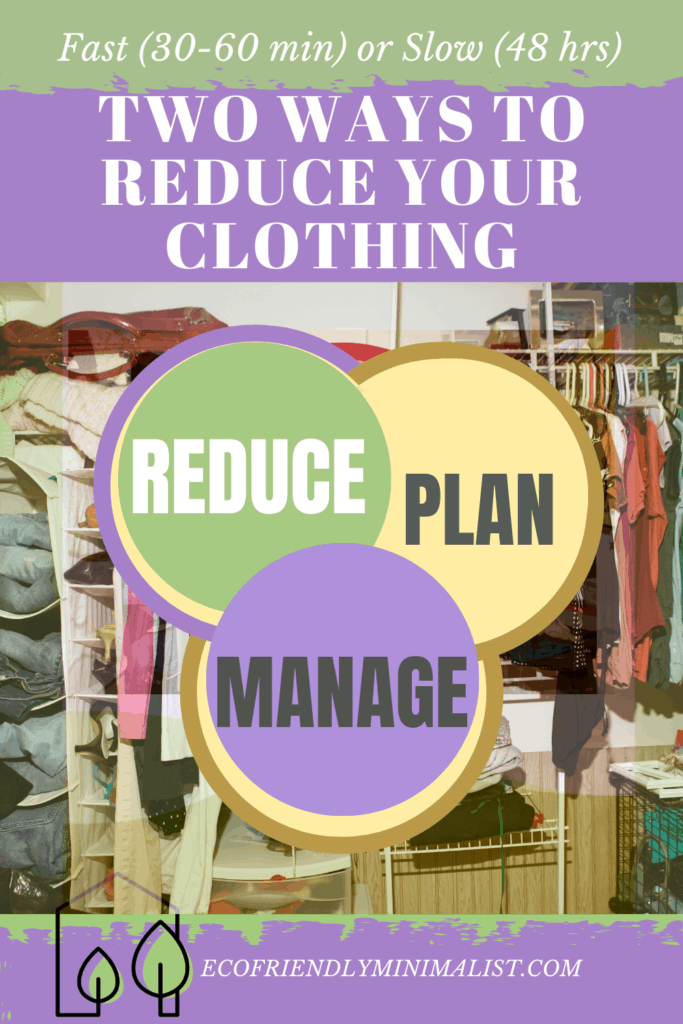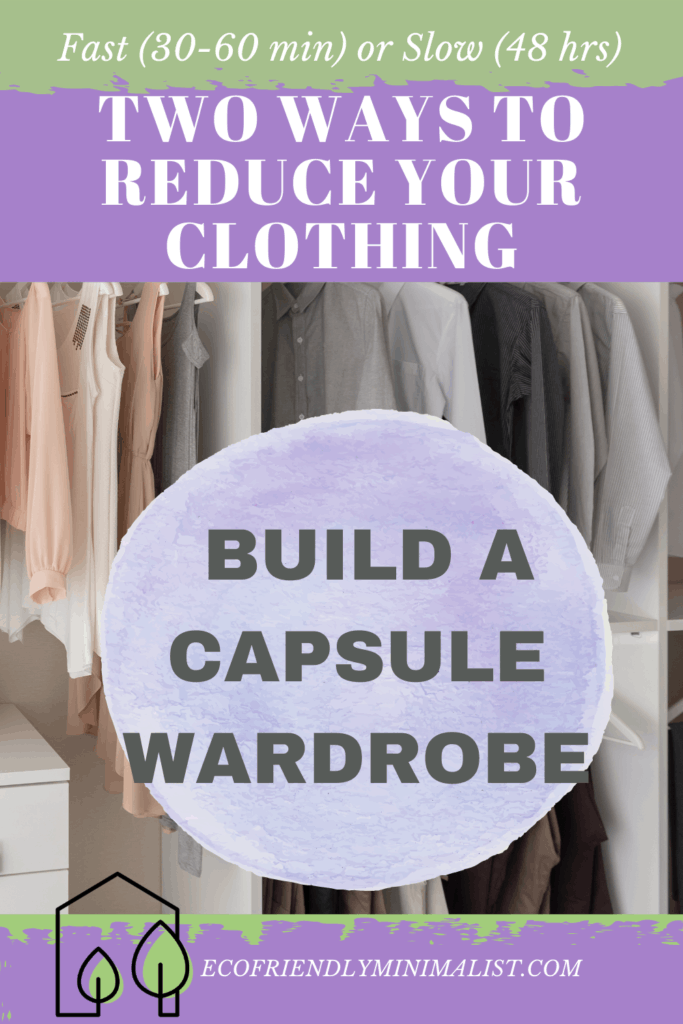Is your closet stuffed with clothes? Do you dread doing your laundry because there’s just too much? I’ll show you how to declutter your clothing TWO WAYS: either fast (30-60 minutes) or slow (maybe a weekend.) Please keep reading to get my step-by-step directions for organizing your closet to simplify your life.
The ‘Active’ Clutter of Clothing
What is Active Clutter? You know, you get up in the morning and start to get ready for the day. You peel off your p.j.s and search for something to wear. As you open your closet door to take a peek . . . you gasp!
There it is… piles everywhere! All your worn clothes from the past few days are lying over the laundry basket filled with clean clothes, hanging on hooks, or sprawled over a chair.
To top it off, clean clothes might be in the piles, too, because when you tried on that shirt the other day, and it didn’t go with those pants, you didn’t re-hang it. Now, the piles have grown too high to decipher what’s there. You’re going to need some time to go through that!
This is ‘active’ clutter! The clutter of daily living!

Let’s face it, taking care of your clothes is A LOT of work! Doesn’t reducing the amount of clothing in your closet make sense? Less to manage equals an easier life.
One thing is for sure: using a seasonal clothing system like a capsule wardrobe will help make your clothing management system easier!
For now, let’s take a look at The Clutter Cycle related to clothing:
The Clutter Cycle – Clothing
We feel like we can never “catch up” on decluttering our closets because managing our clothing:
- Requires shopping – We usually don’t plan our wardrobes and casually pick up fast fashion.
- Creates an accumulation of clothing – Our closets fill up over time.
- Requires storage – Maintaining our closets and drawers is a lot of work!
- Requires management – WASHING, DRYING, FOLDING, PUTTING AWAY – a lot of work!
- And eventually, purging or disposal – Usually, we don’t have purging routines, so clothing piles up over time.
If we Reduce, Plan, and Manage our clothes, it will make your daily life easier.

REDUCE
We all have too many clothes in our closets and know we won’t wear many. I’ve heard that we only wear about 20% of the clothes in our closets.
But of course, we do have our favorites! I know I do. Comfortable clothing is my go-to. What’s yours?
How To Purge Your Clothes – Fast
To cut your clothes in half (or even more) quickly, do this:
1. Choose a specific number of clothes to wear for the current season (spring, summer, fall, or winter). Thirty to forty is a good number.
2. PUT THE REMAINING CLOTHES IN STORAGE.
I use a large suitcase to store my out-of-season clothing. Tossing in excess clothing gives you time to go through it and make more permanent decisions.
This is a super quick way to get control of your closet immediately without making any decisions.
Okay, that was easy! But, if you have the time and want to make a more permanent reduction, follow the steps outlined below.

How to Purge Your Clothes Slowly – Step-By-Step
SORT INTO THESE FOUR CATEGORIES
THE CLOTHES YOU LOVE – Make a pile of clothes you love wearing.
- SEASONAL– Store clothes out of season elsewhere.
- CLOTHES THAT DON’T FIT WELL, ARE UNCOMFORTABLE, OR YOU’RE NOT SURE – Store these elsewhere until a later time.
- NON-CLOTHING ITEMS – Remove all non-clothing items from the closet and store elsewhere. Find it another home! This is a must! Only clothes go into the closet!
Notes
- If it’s uncomfortable, consider purging it.
- If you’re NOT SURE, consider purging it.
- Remove all non-clothing items and find them another home. Only keep clothing in your closet.
- Move off-season items out of the closet
- Move clothes that you’re not sure about out of the closet
What To Do With Clothes That You Don’t Want
- Give them away to friends or family;
- Donate to a charity;
- Sell online;
- Create a friend swap;
- Up-cycle or repurpose
Where to Store Your Excess, Out of Season, and Tight Clothing
- In a suitcase
- In a drawer or in another room
- In garbage bags stored in the garage
- Under the bed
- Definitely don’t keep them in your closet
PLAN
CHOOSE YOUR FAVORITE CLOTHES & RETURN THEM TO YOUR CLOSET
You can simply return your favorite clothes to your closet or, you can plan a capsule wardrobe, which is an intentional wardrobe made up of a limited amount of items.
Consider keeping the number to a minimum, like thirty items. This does not include pajamas, athletic wear or under-clothing, shoes, or accessories.
Keep a limited number of shoes in your closet suitable to the season.
Consider Making a Capsule Wardrobe
A CAPSULE WARDROBE IS:
- A collection of core clothing pieces like pants, shirts/tops, skirts/dresses, and sweaters/jackets;
- Usually contains a finite number, maybe 30-40 pieces;
- Should fit well;
- Should coordinate together, or be mix and match;
- These should be items that you love or, at least, like and currently wear and
- Be seasonal
A CAPSULE WARDROBE CAN ALSO BE:
- Fashionable
- Timeless
- Quality (over quantity)
- Organized by color or brand
- Made up of ethical brands
- For a specific purpose, like for work

CHANGE YOUR HABITS
- Stop impulse buying
- Bad habits are hard to break, especially when we see cheap clothing or sales.
- Impulse buying adds to the clutter in our closets, especially when we don’t return items that don’t work.
- Creating a capsule wardrobe will give you the tools to shop intentionally for only what you actually need to complete your seasonal wardrobe.
Well, that’s it! Hope you enjoyed it and find it helpful. Please drop a note and let me know your best closet tips. I’d love to hear from you.
